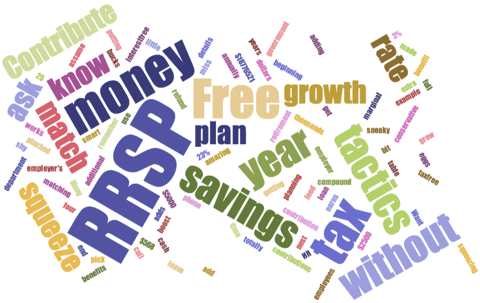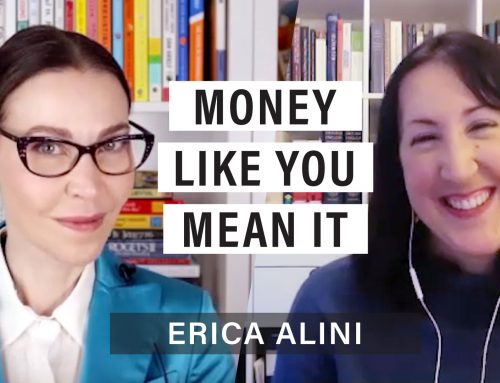I’m feeling the pinch. After balancing my budget spreadsheet, paying the crazy cost of daycare, covering rent, paying off my credit cards, shopping food sales with free grocery apps, and stretching a darn chicken until it clucks, I’m feeling a little tight on cash. I don’t wanna think about saving for retirement now. Thanks me. Bad me.

And then I remember a few sneaky and very smart tactics for squeezing more savings into an RRSP without getting pinched. With a little bit of planning, these four tactics can grow your RRSP savings without you adding any additional dollars to your retirement plan. Promise.
1. Contribute at the beginning of the tax year.
Contribute to your RRSP at the end of the tax year and you totally miss out on a full year of compound growth. Over time this tax-deferred growth can add up to thousands of bucks.
For example, let’s assume you’re putting $5,000 into your RRSP annually. At a very conservative rate of 3%, here’s how the money adds up after 25 years:
Total RRSP by contributing at start of tax year: $187,765.21
Total RRSP by contributing at end of tax year: $182,296.32
Difference: $5,468.89
Note: Calculation based on compounding annually.
By switching your contributions to January 1st, the start of the tax year, you’re giving your RRSP additional time to grow for free by harnessing the power of compound interest.
2. Don’t miss your employer’s match.
Want some free money? Ask your employer if they match RRSP contributions. Many employees don’t know about this amazing benefit and leave the free money on the table. Free money that can boost your nest and feed you eggs. If you don’t know how your RRSP matching plan works, pick up the phone and call your HR department to get the details. Don’t be shy, ask. These are your benefits, so use them.
3. Stop giving the government an interest-free loan.
I used to rejoice every year when my RRSP contribution earned me a nice little tax refund. In hindsight, getting an annual tax refund is akin to giving the government an interest-free loan. Who wants to do that?
If you make regular RRSP contributions you can request to have fewer tax dollars deducted from your paycheque by filing this form: Request to Reduce Tax Deductions at Source (T1213). Paying less income tax throughout the year makes it easier to boost your RRSP contributions, fund your Tax-Free Savings Account, or even pay down your mortgage.
4. Contribute today, defer your deduction for next year?
If you’re expecting a big raise next year after earning a lower income this year, consider deferring your RRSP deduction by a year. By contributing to your RRSP today and saving your tax deduction for when your income is greater, you could save big on taxes by lowering your tax bracket tomorrow.
For example, a $2,500 RRSP contribution made at a marginal tax rate of 23% earns you a $568 tax refund. But by deferring this deduction to next year, when you know you’re income is at a higher marginal tax rate of 37%, you could earn a $913 refund. Note: Exact tax rates will vary from province to province across Canuckland.
By deferring your deduction one year at a higher marginal tax rate, you end up with an extra $345 for the same $2,500 RRSP contribution — this is essentially a guaranteed 13.8% rate of return. Now add these additional dollars to your RRSP and continue to watch it grow!
Love,
Kerry





The RRSP does not grow tax free, it grows tax deferred. You still have to pay tax on the gain – just not until you withdraw it from the RRSP. There is still a benefit to making the contribution sooner rather than later, but no more so than with any non-registered investment.
@Greg Yes, an RRSP grows tax deferred.
Kerry, I always enjoy your articles. They’re on point and well written, methinks. Hubby & I often joke about buying some cases of catfood at Costco for our retirement. : ) I’m toughing it out, holding on to my Blackberry stocks. Actually I sold half of them two years ago after I’d doubled my investement. ( Just peanuts, but I was happy with the results). I like to support Canadian stocks, particularly ones that sell for under $20. Any comments?
I have been using the tax form to reduce withholdings at source for about 7 years or so. It helps pay for my monthly RRSP contributions. It really makes it easier to manage larger monthly RRSP contributions. We also started using it with child care expenses which takes a bit of the bite out of day care costs. Overall it leaves us with a smaller tax refund in March, but who cares – why would I give my cash to the government to hold for me interest free?
One important way to increase your retirement account without spending any cash is to select index funds that have a very low cost. The difference between a 1.5% and 0.10 % may not sound like a huge difference when you are still working…but that 1.4% difference adds up fast. And, if you are retired, as I am, and earning, say, an average of a 6% return on investment, that 1.5% “cost” would be 25% of your income!!!! Whereas a .1% cost of investment would be less than 2% of your income. I have used this strategy for years and it is paying off now. I am NOT eating cat food.